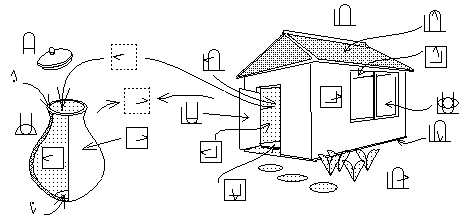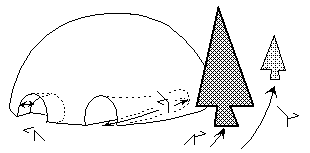![]() : inner
direction/inside/inward (内),
: inner
direction/inside/inward (内), ![]() :
outer direction/outside/outward (外)
:
outer direction/outside/outward (外)
An EL writing goes from the left to the right, so the users feel the left as the original direction and the right as the heading direction or the direction against the subject. Then these symbols are mainly used by the above meanings.
(地球語は左から右へ書き進めるので、左に元があり、右に向かうと離れるイメージがあるところから、多くの重ね文字の中の左・右の矢印は内・外を意味します。)
By the same reason, when these were compounded with(time),
means the past, and
means the future seeing from the present, distinguishing with
(earlier/early) and
(late/later) seeing from any time point. When compounded with a verb mark, the verb
is for a past verb and
is for a future verb.
(同じイメージにより、時と重ねると過去・未来を表し、ある時点を基準にした「前」「後」と区別します。動詞符に重ねると、過去形、未来系の動詞を構成します。)
[Prepositions] (compounding with preposition mark): in,
: at out of ...
(内・外の基礎記号を前置符に重ねて、~の中に/の、~の外に/の という意味の前置詞として使います。)

![]() :
inner surface (内面),
:
inner surface (内面), ![]() :
outer surface (外面)
:
outer surface (外面)
![]() : on the inner
surface of ...(a preposition)
: on the inner
surface of ...(a preposition)
Compounding with ![]() (wall/壁),
(wall/壁),
![]() : inner wall (内壁),
: inner wall (内壁),
![]() : outer wall (外壁)
: outer wall (外壁)
![]() : ceiling (天井),
: ceiling (天井),
![]() : floor (床)
: floor (床)
Compounding with ![]() (building/建物),
(building/建物),
![]() : interior (室内),
: interior (室内),
![]() : exterior (屋外)
: exterior (屋外)
![]() : roof (屋根),
: roof (屋根),
![]() : foundation
of building (建築基礎)
: foundation
of building (建築基礎)
 With
With
![]() (much/多) or
(much/多) or ![]() (less/少):
(less/少):
![]() : deep inside (奥深い),
: deep inside (奥深い),
![]() : far (遠い),
: far (遠い),
![]() : shallow inside
(中に浅い),
: shallow inside
(中に浅い), ![]() :
close (近い)
:
close (近い)
Compounding ![]() or
or ![]() with a symbol of a condition, it shows a
movement/phenomenon/situation related to inside/inward or outside/outward.
with a symbol of a condition, it shows a
movement/phenomenon/situation related to inside/inward or outside/outward.
(状態・行為・動きなどの文字と重ねても、内・外にかかわって意味を構成します。)
and
unrelated to the meaning of Inside and Outside(内外とは無関係の意味で)
These two symbol-shapes point the opposition direction to each other. So they are used for the left and the right (compounding with), for west and east (compounded with
), for oneself and other (with
), and for female and male (with
). Various family relatives such as mother and son are shown using
(female) or
(male) and
(earlier) or
(later) or
(equal level) etc.
(左右反対方向を指す記号のため、重ねる相手によっては左・右のほか、西・東、自・他、雌・雄など対立する意味にも展開します。女・男に世代にかかわる文字を重ねると親族を区別する多くの文字ができます。)Like these ways, many symbols are simply expressed, and are visually understandable. Pages 19 and 20 of the main dictionary have more of these examples.
(こんなふうに見て意味がわかりやすい文字が続々できます。字典の19,20ページの例も参照してください。)